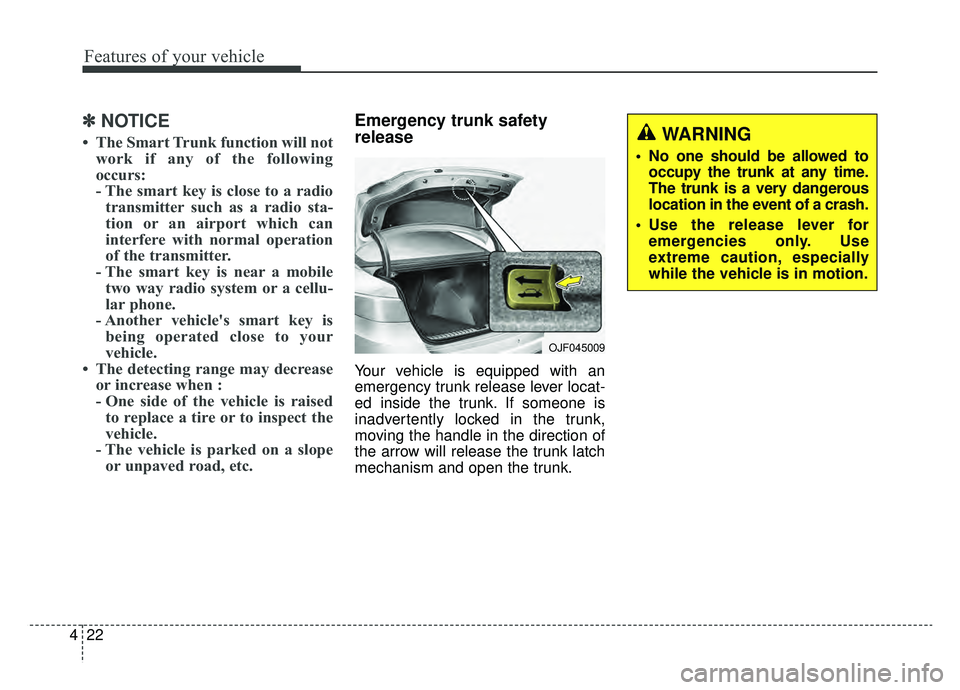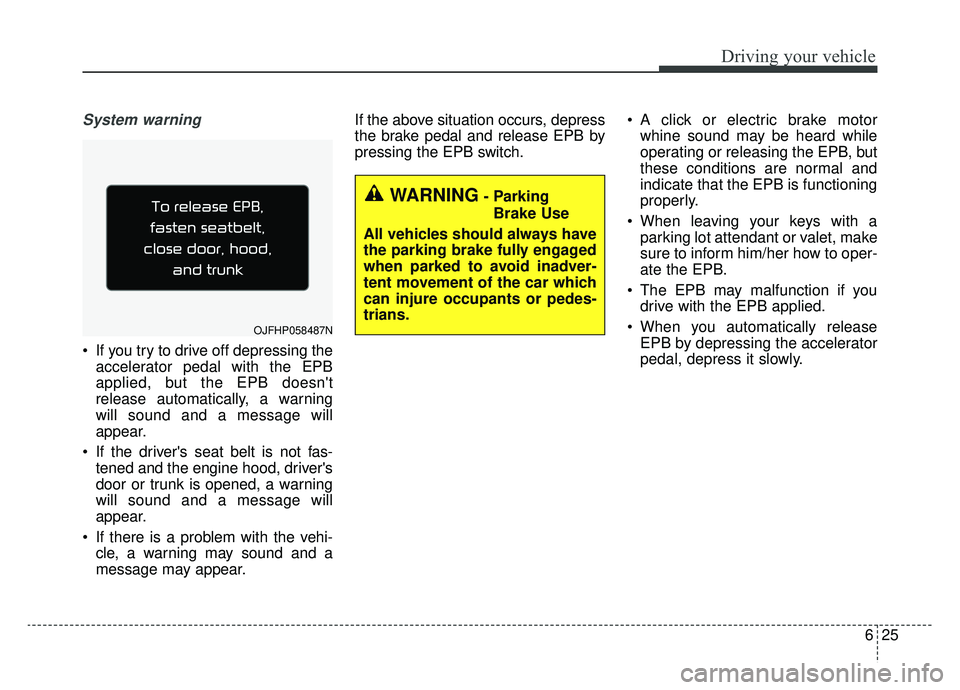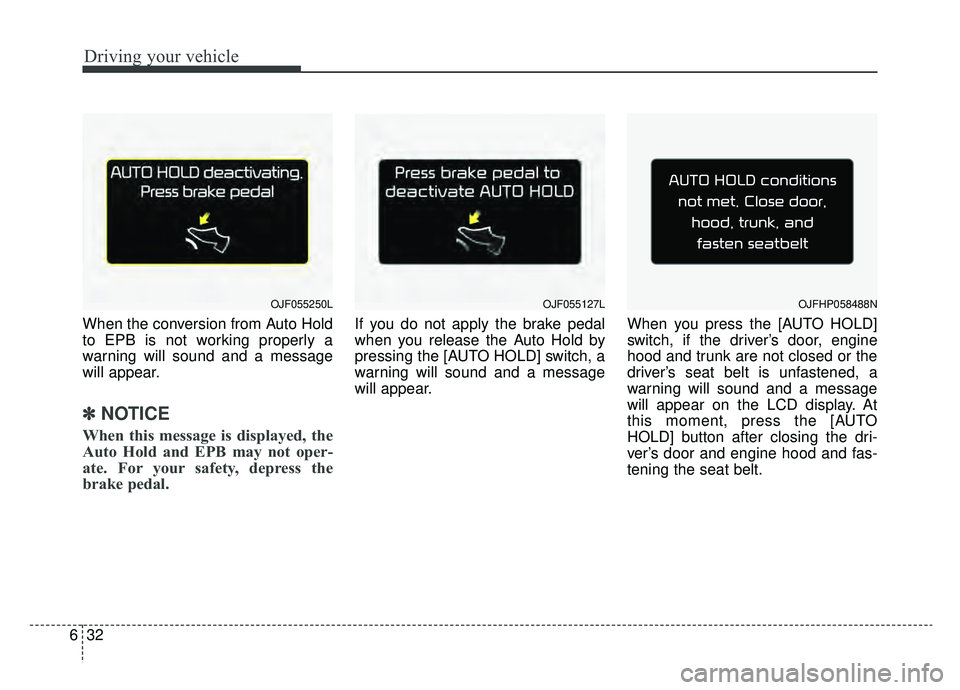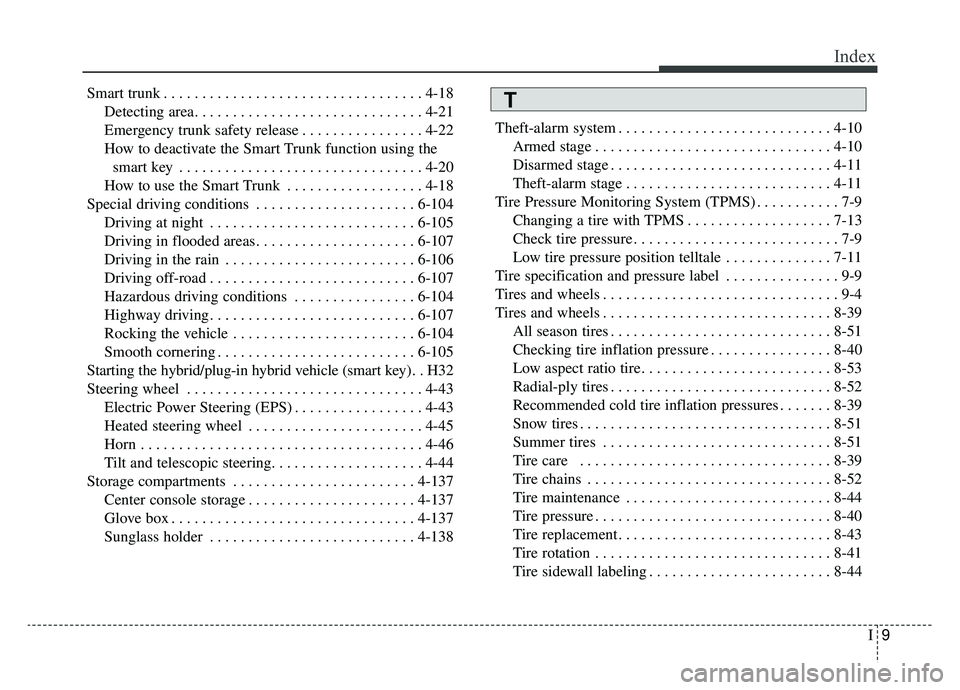2019 KIA OPTIMA HYBRID trunk release
[x] Cancel search: trunk releasePage 134 of 553

Features of your vehicle
44
Record your key number
The key code number
is stamped on the bar
code tag attached to
the key set. Should
you lose your keys,
this number will enable an author-
ized Kia dealer to duplicate the keys
easily. Remove the bar code tag and
store it in a safe place. Also, record
the code number and keep it in a
safe and handy place, but not in the
vehicle.
Smart key function
To remove the mechanical key, press
and hold the release button(1) and
remove the mechanical key (2).
To reinstall the mechanical key, put
the key into the hole and push it until
a click sound is heard. With a smart key, you can lock or
unlock a door (and trunk) and start
the engine.
Refer to the following for more details.
SMART KEY
OJF045325L
WARNING- Smart key
Never leave the keys in your
vehicle with unsupervised chil-
dren. Leaving children unat-
tended in a vehicle with a smart
key is dangerous. Children
copy adults and they could
press the start button. The key
would enable children to oper-
ate power windows or other
controls, or even make the vehi-
cle move, which could result in
serious bodily injury or death.
Page 152 of 553

Features of your vehicle
22
4
✽ ✽
NOTICE
• The Smart Trunk function will not
work if any of the following
occurs:
- The smart key is close to a radiotransmitter such as a radio sta-
tion or an airport which can
interfere with normal operation
of the transmitter.
- The smart key is near a mobile two way radio system or a cellu-
lar phone.
- Another vehicle's smart key is being operated close to your
vehicle.
• The detecting range may decrease or increase when :
- One side of the vehicle is raisedto replace a tire or to inspect the
vehicle.
- The vehicle is parked on a slope or unpaved road, etc.
Emergency trunk safety
release
Your vehicle is equipped with an
emergency trunk release lever locat-
ed inside the trunk. If someone is
inadvertently locked in the trunk,
moving the handle in the direction of
the arrow will release the trunk latch
mechanism and open the trunk.
OJF045009
WARNING
No one should be allowed to
occupy the trunk at any time.
The trunk is a very dangerous
location in the event of a crash.
Use the release lever for emergencies only. Use
extreme caution, especially
while the vehicle is in motion.
Page 306 of 553

Driving your vehicle
24
6
To release EPB (electronic parking
brake) automatically:
Shift lever in P (Park)
With the engine running depress
the brake pedal and shift out of P
(Park) to R (Reverse) or D (Drive).
Shift lever in N (Neutral) With the engine running depress
the brake pedal and shift out of N
(Neutral) to R (Reverse) or D
(Drive).
Automatic Transaxle 1. Start the engine.
2. Fasten the driver's seat belt.
3. Close the driver's door, engine hood and trunk.
4. Depress the accelerator pedal while the shift lever is in R (Rear),
D (Drive) or Sports mode.
Make sure the brake warning light
goes off.✽ ✽ NOTICE
• For your safety, you can engage
the EPB even though the engine
stop/start button is in the OFF
position, but you cannot release it.
• For your safety, depress the brake pedal and release the parking
brake manually with the EPB
switch when you drive downhill or
when backing up the vehicle.
Do not follow the above procedure
when driving on a flat level ground.
The vehicle may suddenly move for-
ward.
✽ ✽ NOTICE
If the parking brake warning light is
still on even though the EPB has
been released, have the system
checked by an authorized Kia dealer.
EPB (electronic parking brake) may
be automatically applied when:
The EPB is overheated
Requested by other systems
The hybrid system is turned off
with the EPB applied
✽ ✽ NOTICE
For EPB equipped vehicles with the
AUTO HOLD function used while
driving, if the ignition button has
been turned OFF, the EPB will be
engaged automatically. Therefore,
the AUTO HOLD function should
be turned off before the ignition but-
ton is turned OFF.
CAUTION
Do not drive your vehicle with
the EPB applied. It may causeexcessive brake pad and brakerotor wear.
Page 307 of 553

625
Driving your vehicle
System warning
If you try to drive off depressing theaccelerator pedal with the EPB
applied, but the EPB doesn't
release automatically, a warning
will sound and a message will
appear.
If the driver's seat belt is not fas- tened and the engine hood, driver's
door or trunk is opened, a warning
will sound and a message will
appear.
If there is a problem with the vehi- cle, a warning may sound and a
message may appear. If the above situation occurs, depress
the brake pedal and release EPB by
pressing the EPB switch.
A click or electric brake motor
whine sound may be heard while
operating or releasing the EPB, but
these conditions are normal and
indicate that the EPB is functioning
properly.
When leaving your keys with a parking lot attendant or valet, make
sure to inform him/her how to oper-
ate the EPB.
The EPB may malfunction if you drive with the EPB applied.
When you automatically release EPB by depressing the accelerator
pedal, depress it slowly.
OJFHP058487N
WARNING- Parking
Brake Use
All vehicles should always have
the parking brake fully engaged
when parked to avoid inadver-
tent movement of the car which
can injure occupants or pedes-
trians.
Page 314 of 553

Driving your vehicle
32
6
When the conversion from Auto Hold
to EPB is not working properly a
warning will sound and a message
will appear.
✽ ✽
NOTICE
When this message is displayed, the
Auto Hold and EPB may not oper-
ate. For your safety, depress the
brake pedal.
If you do not apply the brake pedal
when you release the Auto Hold by
pressing the [AUTO HOLD] switch, a
warning will sound and a message
will appear. When you press the [AUTO HOLD]
switch, if the driver’s door, engine
hood and trunk are not closed or the
driver’s seat belt is unfastened, a
warning will sound and a message
will appear on the LCD display. At
this moment, press the [AUTO
HOLD] button after closing the dri-
ver’s door and engine hood and fas-
tening the seat belt.
OJF055250LOJF055127LOJFHP058488N
Page 423 of 553

725
What to do in an emergency
When towing your vehicle in an
emergency without wheel dollies :
1. Set the ignition switch in the ACCposition.
2. Place the transaxle shift lever in N (Neutral).
3. Release the parking brake.Removable towing hook
(if equipped)
1. Open the trunk, and remove the towing hook from the tool case.
2. Remove the hole cover pressing the upper part of the cover on the
bumper.
CAUTION - Towing gear
position
Failure to place the transaxleshift lever in N (Neutral) maycause internal damage to thetransaxle.
CAUTION - Towing
Do not tow the vehicle back- wards with the front wheels onthe ground as this may causedamage to the vehicle.
Do not tow with sling-type equipment. Use wheel lift orflatbed equipment.
HXD02
HXD03
OJFHP066017N
Page 550 of 553

I9
Index
Smart trunk . . . . . . . . . . . . . . . . . . . . . . . . . . . . . . . . . . 4-18\
Detecting area. . . . . . . . . . . . . . . . . . . . . . . . . . . . . . 4-21
Emergency trunk safety release . . . . . . . . . . . . . . . . 4-22
How to deactivate the Smart Trunk function using the smart key . . . . . . . . . . . . . . . . . . . . . . . . . . . . . . . . 4-20
How to use the Smart Trunk . . . . . . . . . . . . . . . . . . 4-18
Special driving conditions . . . . . . . . . . . . . . . . . . . . . 6-104 Driving at night . . . . . . . . . . . . . . . . . . . . . . . . . . . 6-105
Driving in flooded areas. . . . . . . . . . . . . . . . . . . . . 6-107
Driving in the rain . . . . . . . . . . . . . . . . . . . . . . . . . 6-106
Driving off-road . . . . . . . . . . . . . . . . . . . . . . . . . . . 6-107
Hazardous driving conditions . . . . . . . . . . . . . . . . 6-104
Highway driving . . . . . . . . . . . . . . . . . . . . . . . . . . . 6-107
Rocking the vehicle . . . . . . . . . . . . . . . . . . . . . . . . 6-104
Smooth cornering . . . . . . . . . . . . . . . . . . . . . . . . . . 6-105
Starting the hybrid/plug-in hybrid vehicle (smart key). . H32
Steering wheel . . . . . . . . . . . . . . . . . . . . . . . . . . . . . . . 4-43 Electric Power Steering (EPS) . . . . . . . . . . . . . . . . . 4-43
Heated steering wheel . . . . . . . . . . . . . . . . . . . . . . . 4-45
Horn . . . . . . . . . . . . . . . . . . . . . . . . . . . . . . . . . . . . \
. 4-46
Tilt and telescopic steering. . . . . . . . . . . . . . . . . . . . 4-44
Storage compartments . . . . . . . . . . . . . . . . . . . . . . . . 4-137 Center console storage . . . . . . . . . . . . . . . . . . . . . . 4-137
Glove box . . . . . . . . . . . . . . . . . . . . . . . . . . . . . . . . 4-137
Sunglass holder . . . . . . . . . . . . . . . . . . . . . . . . . . . 4-138 Theft-alarm system . . . . . . . . . . . . . . . . . . . . . . . . . . . . 4-10
Armed stage . . . . . . . . . . . . . . . . . . . . . . . . . . . . . . . 4-10
Disarmed stage . . . . . . . . . . . . . . . . . . . . . . . . . . . . . 4-11
Theft-alarm stage . . . . . . . . . . . . . . . . . . . . . . . . . . . 4-11
Tire Pressure Monitoring System (TPMS) . . . . . . . . . . . 7-9 Changing a tire with TPMS . . . . . . . . . . . . . . . . . . . 7-13
Check tire pressure . . . . . . . . . . . . . . . . . . . . . . . . . . . 7-9
Low tire pressure position telltale . . . . . . . . . . . . . . 7-11
Tire specification and pressure label . . . . . . . . . . . . . . . 9-9
Tires and wheels . . . . . . . . . . . . . . . . . . . . . . . . . . . . . . . 9-4
Tires and wheels . . . . . . . . . . . . . . . . . . . . . . . . . . . . . . 8-39 All season tires . . . . . . . . . . . . . . . . . . . . . . . . . . . . . 8-51
Checking tire inflation pressure . . . . . . . . . . . . . . . . 8-40
Low aspect ratio tire. . . . . . . . . . . . . . . . . . . . . . . . . 8-53
Radial-ply tires . . . . . . . . . . . . . . . . . . . . . . . . . . . . . 8-52
Recommended cold tire inflation pressures . . . . . . . 8-39
Snow tires . . . . . . . . . . . . . . . . . . . . . . . . . . . . . . . . . 8-51
Summer tires . . . . . . . . . . . . . . . . . . . . . . . . . . . . . . 8-51
Tire care . . . . . . . . . . . . . . . . . . . . . . . . . . . . . . . . . 8-39
Tire chains . . . . . . . . . . . . . . . . . . . . . . . . . . . . . . . . 8-52
Tire maintenance . . . . . . . . . . . . . . . . . . . . . . . . . . . 8-44
Tire pressure . . . . . . . . . . . . . . . . . . . . . . . . . . . . . . . 8-40
Tire replacement . . . . . . . . . . . . . . . . . . . . . . . . . . . . 8-43
Tire rotation . . . . . . . . . . . . . . . . . . . . . . . . . . . . . . . 8-41
Tire sidewall labeling . . . . . . . . . . . . . . . . . . . . . . . . 8-44T